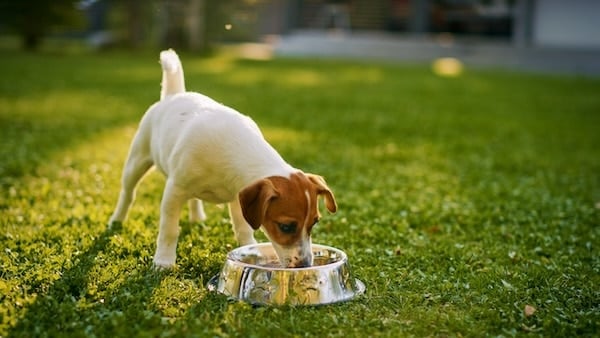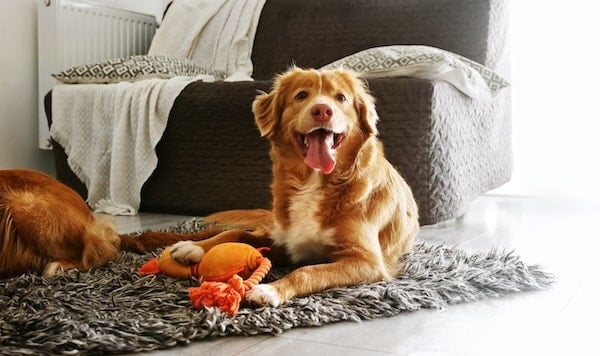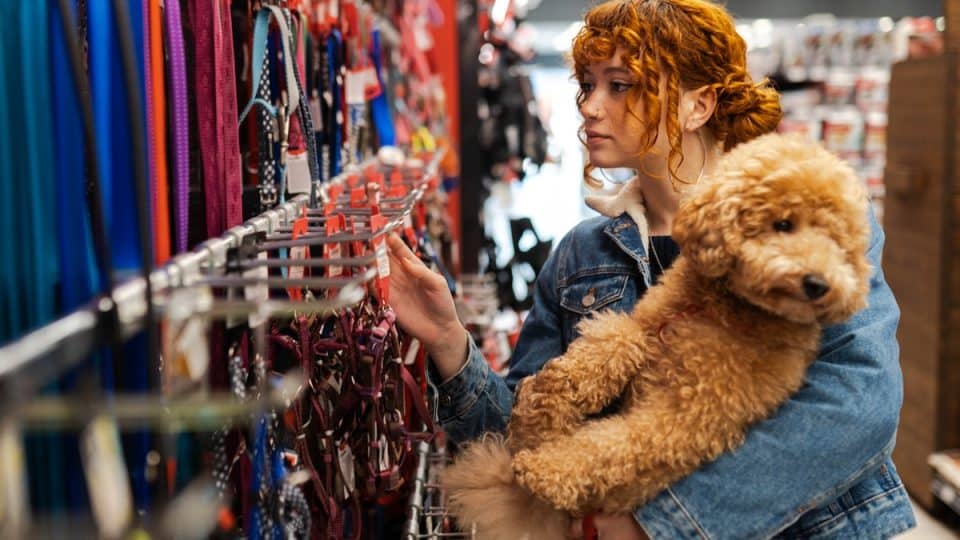- This post contains affiliate links. Read more here.
- Not a substitute for professional veterinary help.
Walk into any pet store, and it’s clear there are A LOT of items for dogs. From kibble, wet food, clothing, toys, paw balms, vitamins, leashes, wipes, treats, and more, it can be confusing to nail down the essential items every dog parent should own.
Here are the basics every dog parent should have on hand.
The Right Kind of Dog Food
Every dog needs food. The tricky part is figuring out the right kind of dog food.
The good news is the Association of American Feed Control Offices (AAFCO) has developed nutrient requirements for commercial pet foods. To get started, look for a food that says on the package that it meets AAFCO standards, is complete and balanced, and is made for your pup’s life stage and breed size.
As for the food type, consider your pup’s preferences, your budget, and how much effort you’d like to make when it comes to food storage. Popular options include:
- Kibble or dry food. One of the most common choices, kibble or dry dog foods are easy to store, relatively affordable, and widely available.
- Wet or canned food. Picky eaters or dogs who need a boost of hydration often do well on wet or canned food diets.
- Fresh food. Fresh dog food is usually gently cooked, then frozen for you to defrost and serve at home. Many fresh foods are part of a subscription service, and while they’re highly palatable, they also tend to be pricey.
- Freeze-dried raw. Though they’ve become a popular choice for some dog parents, raw dog foods can be dangerous for dogs with compromised immune systems or puppies. It’s important to talk with your vet to determine if this is a safe option for your pup.

gorodenkoff via iStock
Proper Bed and Bedding Materials
Dogs need a space they know is their own. That’s why having bedding for them is essential. When properly introduced, dog crates can help reduce anxiety, promote rest and relaxation, and help establish boundaries.
When it comes to choosing the best dog bed for your pup, this will depend on their size, temperament, and preferences.
- Puppies require durable beds that are easy to clean. The PetFusion Ultimate is a nice tough option that also has a removable cover that’s machine washable.
- Older and larger dog breeds benefit the most from orthopedic dog beds, but they’re an excellent choice for dogs of all sizes and breeds due to their comfort and support.
- If your dog suffers from anxiety or likes to sleep curled up, the Best Friends by Sheri Original Calming Donut is a popular calming bed that dog parents rave about—including our calming bed testers.
Walking Gear and Equipment
Exercise is essential for dogs, and taking them on walks is one of the best and easiest ways to provide this. Here’s the dog walking gear you should have on hand.
- Leash. While there are many kinds of leashes (like hands-free leashes, long lines, and waterproof leads), it’s a good idea always to have one or two basic 6-foot nylon leashes for walks or trips outside the house.
- Harness and collar. Collars are important for holding your dog’s ID tags, and harnesses can add a layer of safety by evenly distributing pressure—especially for more powerful pups and small breeds with vulnerable necks.
- Poop bags. Every walk needs a roll of sturdy poop bags. A poop bag holder that attaches to your leash makes sure you always have one on hand.
- Treat pouch. Walks are a great opportunity to reinforce training, and a treat holder makes it easy to ensure rewards are always on hand.
Toys for Enrichment
Having toys and enrichment opportunities are critical to a dog’s well-being. They help prevent boredom, relieve stress, satisfy natural canine instincts (like chewing or digging), and strengthen your bond. Need a place to start? Try these classics.
- The KONG Classic Red Rubber Toy (just called a “KONG” by most of the dog world) is an excellent interactive dog toy to have on hand. You can stuff it with treats, dog-safe peanut butter, or yogurt for a fun enrichment activity for your pup.
- Treat dispensers like the Bob-a-Lot are another fun way to keep your dog busy and entertained.
- Puzzle toys are an excellent rainy-day activity to help your pup release energy. Just hide their favorite treats inside and let them explore.

Zheka-Boss via iStock
Grooming for Hygiene
Whether you have a short or long-haired dog, grooming is essential. Grooming your dog helps them stay clean and happy. And while some pet parents have their dogs professionally groomed, it’s always a good idea to have these items on hand just in case.
- Brush. The right brush for your dog will depend on their coat type. Rake brushes are ideal for thick double coats, bristle or rubber brushes are good for short hair, and slicker brushes are good for medium, long, and curly-haired dogs.
- Shampoo. Dogs need dog-specific shampoo for regular baths. Even if you get your pup groomed, having a bottle of shampoo in your closet is a good idea for muddy or messy situations. Dry dog shampoo can help in a pinch.
- Nail trimmers. Trimming your dog’s nails regularly helps prevent accidents, like getting their nail caught on something and scratching up hardwood floors.
- Toothbrush and dog toothpaste. Dogs need clean teeth for optimum health. Using a toothbrush and toothpaste is the best way to do it. Dental chews are also helpful in removing plaque—though most vets will tell you chews aren’t enough on their own.
- Wipes. Whether it’s cleaning muddy paws or tear-stained eyes, pet-safe wipes come in handy for a variety of purposes.
Travel and On-the-go Essentials
If you like to go on adventures with your pup, a travel kit is essential to have on hand. This can include anything from a dog first aid kit to travel bowls to provide your pup with water and food breaks on the go.
While travel kits may differ depending on whether you’re roadtripping, hiking, or flying, these items can get you started.
- Travel bowl and water to keep your pup hydrated and energized on breaks.
- Waterproof travel bed and/or blanket as a place of comfort and security during your trip.
- Car harness and/or travel crate to keep your dog safe in the car.
Routines for Wellbeing
One of the most important things to make sure to set aside for your dog is time. There are a lot of routines that you’ll want to get in place for their care. Here are some basics to plan for.
How often should you take your dog to the vet?
This will differ depending on your dog’s personal health and needs, but on average, your dog should have an annual physical/checkup at least once a year. This will ensure they’re up to date on their shots and in good health. Puppies and senior dogs may need to go more often.
How often should you groom your dog?
This depends on your dog’s hair and breed, but you should plan to brush your dog at least once a week at home. It’s recommended that short and long-haired dogs get groomed every 4-6 weeks, while double-coated canines should get groomed monthly.
How often should you walk your dog?
Most adult dogs should get two 15- to 30-minute walks per day. This varies depending on your dog’s age, health, and exercise needs.
How often should you play with your dog?
Just like exercise, dogs need interaction and enrichment. One of the best ways to provide this is by playing with them, whether that’s a game of fetch or tug with their favorite toy. The rule of thumb is that dogs need about 30 minutes of playtime each day.




